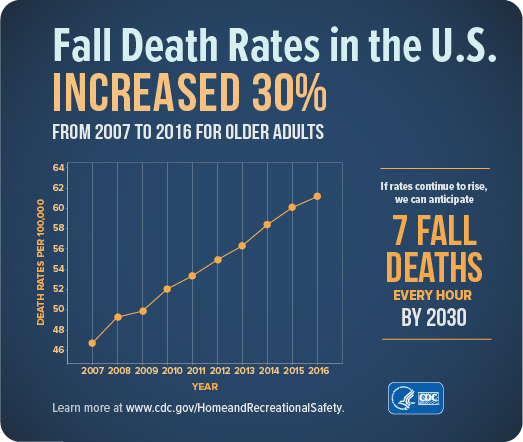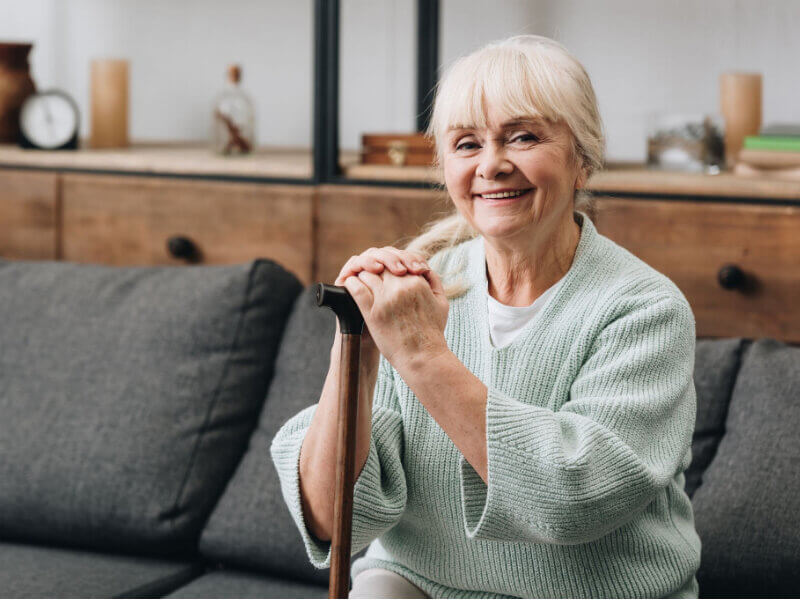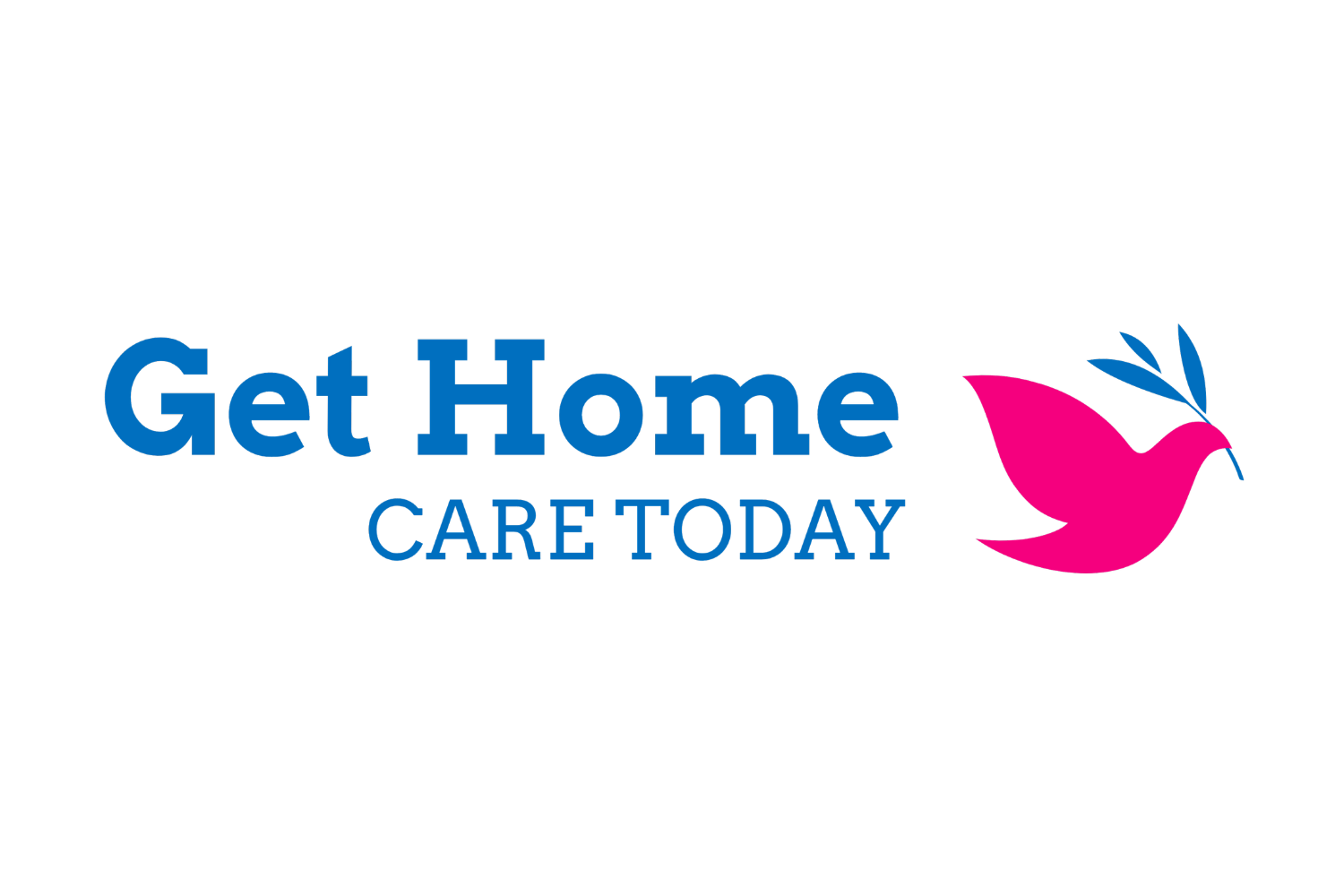Preventing Senior Falls Is About Staying Safe
But how do you simply stop them from happening?
The answer to that is you can’t but there’s plenty you can do to prevent senior falls from happening.
As you get older, your body naturally wears down and those long strides you used to take when you were younger now becomes shorter and slower steps.
As a full service home health and home care agency, JanCare is able to provide a full analysis and care plan suited to each individual clients medical and personal needs.
You probably thought about many different ways to care for your loved one like safe guarding their home or reading up on how to make sure their cared for properly!
An you should be concerned because senior falls happen everyday!
Some studies have even shown that for every 11 seconds that passes a senior is being treated for a fall and every 19 minutes a senior dies from a fall.
That’s scary to think about when all you want for your loved one is to be happy and healthy.
So today, I’m going to help you understand the importance of senior fall prevention, answer common questions and provide you with simple steps on how to prevent senior falls.
Why Are Falls So Dangerous For The Elderly?
To put it simply, the older you get the more your body starts to wear down and little bumps into a wall when you were younger now feels like you might’ve fell down a flight of steps.
You probably noticed that most elderly people have body types that are more on the frail side like a loss of muscle, stamina, endurance, and sometimes weight.
With elderly people having such weak bodies, it’s no wonder why fall death rates have been rapidly increasing. In fact, the Center of Disease Control (CDC) reported the fall death toll is on pace to reach 7 deaths per hour by 2030!

Rochester University even reported there own study stating that about 30 percent of adults older than 65 years will experience an unintentional fall each year.
The CDC has even made it easy for people to review their state and see reported fall rates.
Check with a doctor to see if you or your loved one fits the criteria of being frail because frailty is one of the primary reasons for increased falls, hospitalization, and mortality.
Another common injury among senior falls are broken hips. They are very hard to recover from and often times most people can no longer live on their own.According to a study by the CDC they found the following:
- Each year over 300,000 older adults, 65 and older, are hospitalized for hip fractures.
- More than 95% of hip fracture cases are caused by falling, usually by falling sideways.
- Women fall more than men, experiencing three-quarters more of all hip fractures.
- Women more often have osteoporosis, a disease that weakens bones and makes them more likely to break.
- The chances of breaking your hip go up as you get older.
A senior falling once can easily double the chances of it happening again and because most seniors don’t always tell their doctors about their falls its important to try to get ahead of the situation whenever you can.
Now if you thought having a weak body was the only thing an elderly person had to think about your wrong unfortunately.
Seniors also have to think about current or pre-existing disabilities, vision problems and even medical complications, like heart disease, that also influence a seniors fall rate.
An that’s why The Journal of Trauma and Acute Care Surgery reported that all elderly fall victims be reviewed thoroughly because of their high in-hospital morality.
As far as injuries go, any given fall from a senior can cause anything from lacerations, hip fractures, head traumas, broken bone fragments causing lung embolisms and more!
In most cases, the danger lies in the life-threatening complications, which can occur when things like rib bones move out of place, leading to punctures and damage to the lungs, critical blood vessels or other organs.
Keep in mind, the result in death isn’t always because of the initial injury but in fact due to the associated problems.
To help you understand things a bit better we’ll use an example of someone who’s been a victim of a senior falls.

Here’s Beth, a senior citizen who recently retired at the age of 65. She’s healthy, strong, loves reading, taking long walks by Bowdoin Park, and simply loves entertaining guests. Recently, she tripped over a branch while she was on her daily walk and had to get hospitalized because of a hip fracture. Shortly after being released, Beth tried to get dinner ready for a get together and tripped over her rug that was no higher than a few centimeters tall and was back in the hospital. Luckily, there was no further breaks to her hip but the doctor now prescribed a home health care aide to monitor her recovery.
This is everyday life for the elderly who can experience a senior falls more as they get older and their bodies become weaker.
That’s why it’s important to know the risks that comes with age and the difference between home care and home health care.
Always consult with home health care agencies that also provide home care solutions so that you get can get everything you need under one roof just like JanCare.
Now let’s discuss…
What Are The Most Common Causes For Senior Falls?
We already went over a few situations that can cause elder falls such as being frail and current or pre-existing disabilities being significant factors but let’s get more in depth.
The more you know about the why something happens will ultimately help you figure out ways to prevent senior falls from occurring in the first place.
A good place to start is by knowing more about some of the driving factors behind what causes these falls such as impaired balance, hazardous environments or situations.
To give you a better idea, imagine someone with high blood pressure and impaired vision, as your physical conditions, tripping over a rug no thicker than a few centimeters high, your environmental hazard, because they were trying to answer the door bell, your potential hazardous situation.
Seem like a normal situation you wouldn’t think twice about safe guarding but yes this is one of the most common falls among seniors simply trying to get around the house.
Here’s a list of a few physical impairments you should be aware of:
- Balance or walking
- Vision
- Sensation, particularly in the feet
- Muscle strength
- Cognition
- Blood pressure or heartbeat
The next list is are drugs that can affect your attention and increase the risk of falling:
- Opioid analgesics
- Antianxiety drugs
- Antidepressant drugs
- Antihypertensive
- Diuretic
- and more!
Some of the described drugs are in association with specific medical conditions and should be discussed with a doctor for best practices.
This list will show you some of the symptoms that could occur if you don’t get help after a fall fast enough:
- Dehydration
- Low body temperature (hypothermia)
- Pneumonia
- Rhabdomyolysis (muscle breakdown that can lead to kidney damage or failure)
- Pressure sores
This should give you a great basis to think about common things to watch out for when it comes to senior fall prevention.
Are Senior Falls Cheap?
That couldn’t be further from the truth! Senior falls are EXPENSIVE!
The financial costs of falling can be very serious and cause substantial medical bills.
The direct medical costs for falls are $31 billion every year and that number is expected to increase as the population continues to age.
The projected financial toll for older adult falls has the potential to reach $67.7 billion during the 2020 year alone.
I pulled some data from the CDC to give you an idea of the statistics behind the cost.
- One out of five falls causes a serious injury such as broken bones or a head injury.
- Each year, 3 million older adults are treated in emergency departments for fall injuries.
- Over 800,000 patients a year are hospitalized because of a fall injury, most often because of a head injury or hip fracture.
- Each year at least 300,000 older people are hospitalized for hip fractures.
- More than 95% of hip fractures are caused by falling, 8 usually by falling sideways.
- Falls are the most common cause of traumatic brain injuries (TBI).
In 2015, the total medical costs for falls totaled more than $50 Billion while Medicare and Medicaid shouldered 75% of these costs.
Yes, that’s Billion with a capital B!
So even if your living your best life the financial toll for senior falls are just too high!
A major issue for seniors is that they have a slower recovery time, and sometimes due to their health, are unable to recover fully from their injuries creating even further future costs.
Now that you have an idea of the dangers, common causes, and costs behind senior falls we could get into the main question of this article.
How Do You Prevent Senior Falls?
What I’ll do in this section is break this down into easy digest steps that will help you take the appropriate measures in preventing senior falls.
The goal of this article is to address and minimize hazards before they can pose a threat to an aging loved one’s health. Every accident can’t be avoided, but you can make sure you take the necessary precautions to reduce the risk of accidents.
Step 1: Talk To Your Doctor
You’d be surprised at how much of an oversight this topic is for the elderly and is why this was made first on this list.
Simply ask your doctor or healthcare provider to evaluate your risk for falling and talk with them about specific things you can do to prevent accidents from happening to you.
In some cases, a physical therapist may need to train you to walk especially if you’re using an assistive device such as a wheelchair, walker or cane because if used the wrong way you could end up doing more harm than good to yourself.
Make sure that you’re as open as possible about everything including any conditions around your physical or mental health and especially about any past falls.You should ask your doctor or pharmacist to review your medication to see if any might make you dizzy or sleepy. This should include both prescription and over-the-counter medicines.
In case you’re talking to your doctor after a fall related injury, here’s a few helpful questions you could ask:
- Do I need additional treatment?
- Do I need physical therapy?
- When can I start exercising on my own again?
- Will I ever return to the same fitness level?
- Is it okay to try this specific activity?
- What should I do if I experience pain while I’m exercising?
Ask your doctor or healthcare provider about taking vitamin D supplements and be sure to get screened for Osteoporosis or frailty for potential treatment.
Step 2: Get Your Eyes Checked
As a rule of thumb, you should be getting your eyes checked by an eye doctor at least once a year, and update your eyeglasses as needed.
If you have bifocal or progressive lenses, you may want to consider getting a pair of glasses prescribed for distance such as outdoor activities, like walking. Keep in mind these types of lenses can make things seem closer or farther away than they really are.
Step 3: Do Strength And Balance Exercises
You should look into exercises that can make your legs stronger and improve your balance. A good example of this is doing things like aerobics, yoga and balancing exercises such as standing on one leg can help to improve your balance.
A steady exercise routine also lessens the possibility to become frail and for those who are frail your condition can improve. Be sure to balanced meal to help the prevention and treatment of frailty.
Overall having a team by your side such as a geriatric physician, geriatric nurse, social worker, pharmacist, occupational and physical therapists can help keep you safe and healthy. These teams now exist in most geriatric centers and have proven to be invaluable when working together to improve a frail patient’s status.
For elderly people, there’s many senior citizen centers, gyms or clubs that offer group programs at low costs and sometimes free!
You should take advantage of the opportunity rebuild your strength at your own pace.
Step 4: Wear The Right Gear
Wearing comfortable or non-constricting clothes goes a long way in senior falls. The less that you have moving around in your own clothes the easier it will be as mobile possible.
One of the biggest overlooked pieces of clothing is your shoes! The same way you change your footwear to boots for the snow and slippers for summer fun at the beach is the way you should think about daily movement.
You’ll be surprised at how often recommendations to a change in footwear is made so that firm, nonslip soles, and some ankle support, and are being used for daily wear.
Step 5: Daily Improvements To Mobility
The way you move, the way you walk, down to the way you move your head from side to side can be vastly improved to help prevent unexpected falls.
As a rule of thumb, whether you’re sitting or lying down you should always try to get up slowly to prevent things like dizziness from happening as your body adjusts to the change in position.
To help you understand a bit better, try thinking about a time when you might’ve woken up and tried to rush out of bed. That dizzy feeling that you’d get in that situation is common among elderly people which is why best practices like taking your time is needed.
Simple movements like the Epley maneuver can also help some elderly people alleviate dizziness when they move. It simply a manner of turning your head in very specific in specific ways.
Your doctor or home health aid would be doing this with you and if needed could be performed as needed for daily use.
Step 6: Make Your Home Fall Proof
Look around your home and move or get rid of anything that you could potentially trip over. That includes things like electrical or extension cords that are in the way of walking can be eliminated by adding more outlets, or cords can be tacked over doorways or beneath floor coverings.
Next up, get sturdy and secure grab bars for your home and place them by your toilets shower or tubs, and any other places for people who need something to hold onto when they stand up. Make sure to install the grab bars correctly, so that its secure on the wall.
If you have stairs in your home, adding in another set of rails for the other side of the stairs can help with additional support whenever going up or down the steps. Make sure your home has lots of light by adding more or brighter light bulbs so that you could clearly see every and any object that might be in your way as you maneuver around your home. Be sure to keep your steps well lit as well the outside of your home and if possible invest in motion sensor lighting.
Need Further Assistance?
JANCARE is here to help when you need it the most. We’re happy to guide you in the right direction and encourage anyone interested in Home Health or Home Care to Contact Us Today!


Great, thanks for sharing this article. Much thanks again. Awesome.
You have brought up a very superb points, appreciate it for the post.
Way cool! Some very valid points! I appreciate you writing this article and also the rest of the site is extremely good.
Hey, thanks for the post. Much thanks again. Great.
Hello There. I found your weblog using msn. This is a really smartly written article.
You completed certain nice points there. I did a search on the subject and saw you covered a lot more than them, thanks!
I enjoy your work, thanks for sharing all the useful blogs.
Really enjoyed this blog article. Really thank you! Much obliged.
My brother suggested I may like this blog. He was totally right.
I think that everything posted was actually very reasonable.
I am truly grateful to the holder of this website who has shared this great piece of writing at here.
This blog is so good. I will visit the blog every day. Love it. And thank you.
I’ve read some good stuff here. Definitely value here and bookmarking to revisit.
I wonder how much effort you put into this to make it so informative website.
We put a lot of effort into making sure you receive the best content available. Thanks for the compliments!
Definitely absorbing data, thanks so much for publishing!
Your most welcome 😀
I have been absent for some time, but now I remember why I used to love this site. Thanks, I will try and check back more often. How frequently you update your site?
Thank you for the support! We’re updating the site frequently and often times expanding on the current blog site.